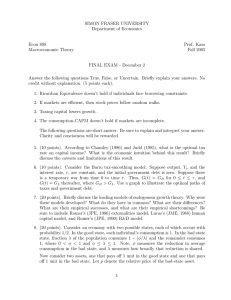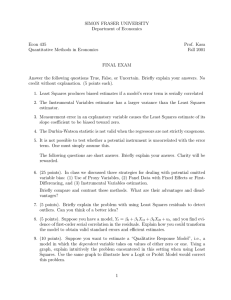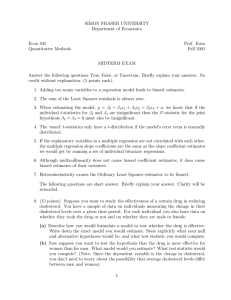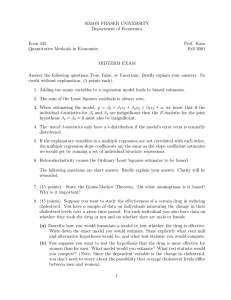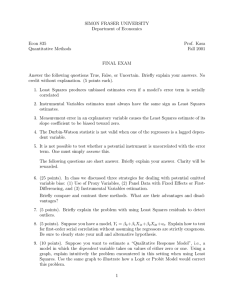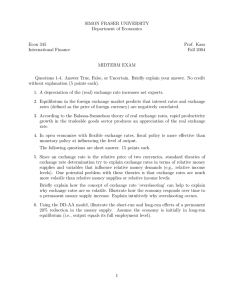SIMON FRASER UNIVERSITY Department of Economics Econ 835 Prof. Kasa
advertisement
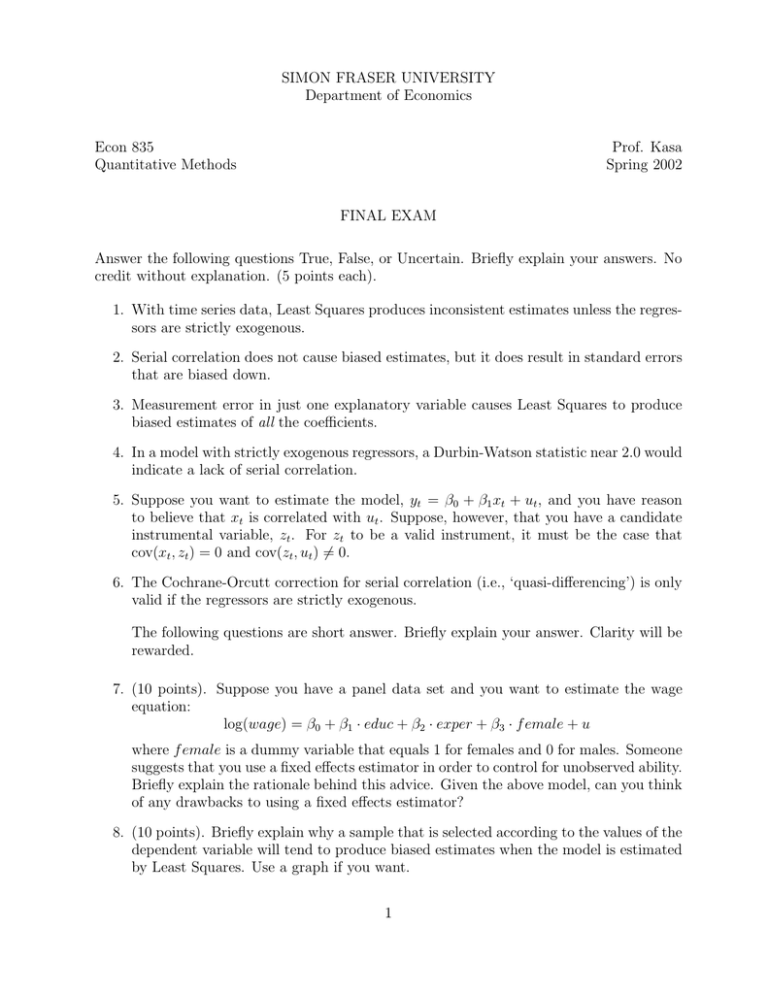
SIMON FRASER UNIVERSITY Department of Economics Econ 835 Quantitative Methods Prof. Kasa Spring 2002 FINAL EXAM Answer the following questions True, False, or Uncertain. Briefly explain your answers. No credit without explanation. (5 points each). 1. With time series data, Least Squares produces inconsistent estimates unless the regressors are strictly exogenous. 2. Serial correlation does not cause biased estimates, but it does result in standard errors that are biased down. 3. Measurement error in just one explanatory variable causes Least Squares to produce biased estimates of all the coefficients. 4. In a model with strictly exogenous regressors, a Durbin-Watson statistic near 2.0 would indicate a lack of serial correlation. 5. Suppose you want to estimate the model, yt = β0 + β1 xt + ut , and you have reason to believe that xt is correlated with ut . Suppose, however, that you have a candidate instrumental variable, zt . For zt to be a valid instrument, it must be the case that cov(xt , zt ) = 0 and cov(zt , ut ) = 0. 6. The Cochrane-Orcutt correction for serial correlation (i.e., ‘quasi-differencing’) is only valid if the regressors are strictly exogenous. The following questions are short answer. Briefly explain your answer. Clarity will be rewarded. 7. (10 points). Suppose you have a panel data set and you want to estimate the wage equation: log(wage) = β0 + β1 · educ + β2 · exper + β3 · f emale + u where f emale is a dummy variable that equals 1 for females and 0 for males. Someone suggests that you use a fixed effects estimator in order to control for unobserved ability. Briefly explain the rationale behind this advice. Given the above model, can you think of any drawbacks to using a fixed effects estimator? 8. (10 points). Briefly explain why a sample that is selected according to the values of the dependent variable will tend to produce biased estimates when the model is estimated by Least Squares. Use a graph if you want. 1 9. (10 points). Suppose you have a model, Yt = β0 + β1 X1t + β2 X2t + ut . Explain how to test for first-order serial correlation without assuming the regressors are strictly exogenous. Be sure to clearly state your null and alternative hypothesis. 10. (10 points). Consider the regression model: y1 = β0 + β1 y2 + β2 x1 + β3 x3 + u. Suppose you are concerned that y2 is “endogenous” (i.e., correlated with u). Also suppose that z is a candidate instrument for y2 . Explain how to do a Hausman Test to check for the endogeneity of y2 . What test statistic would you compute? What is your null and alternative hypothesis? 11. (10 points). Briefly compare and contrast the Fixed Effects estimator and the Random Effects estimator. Under what circumstances is one preferred to the other? 12. (20 points). Suppose you want to examine the claim that capital punishment deters murder. You have data on murder rates from each of the 50 U.S. states for the years 1970 and 1990. As it turns out, during this period some states passed laws allowing capital punishment. (Assume for simplicity that no state repealed a law allowing capital punishment). Formulate a model that allows you to estimate the deterrent effect of capital punishment. Allow for the possibility that murder rates have changed over time in all states due to unobserved national socioeconomic factors. Also allow for the possibility that there are systematic differences across states in overall crime rates or law enforcement. (Hint: You will need to create two dummy variables). Briefly discuss any caveats to this approach. (Hint: What are you assuming about the process governing capital punishment laws?) 2
